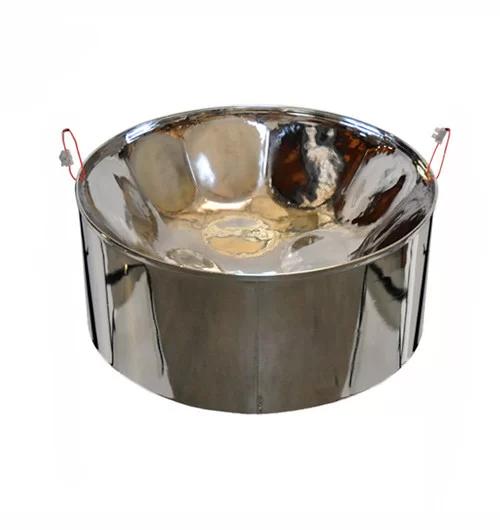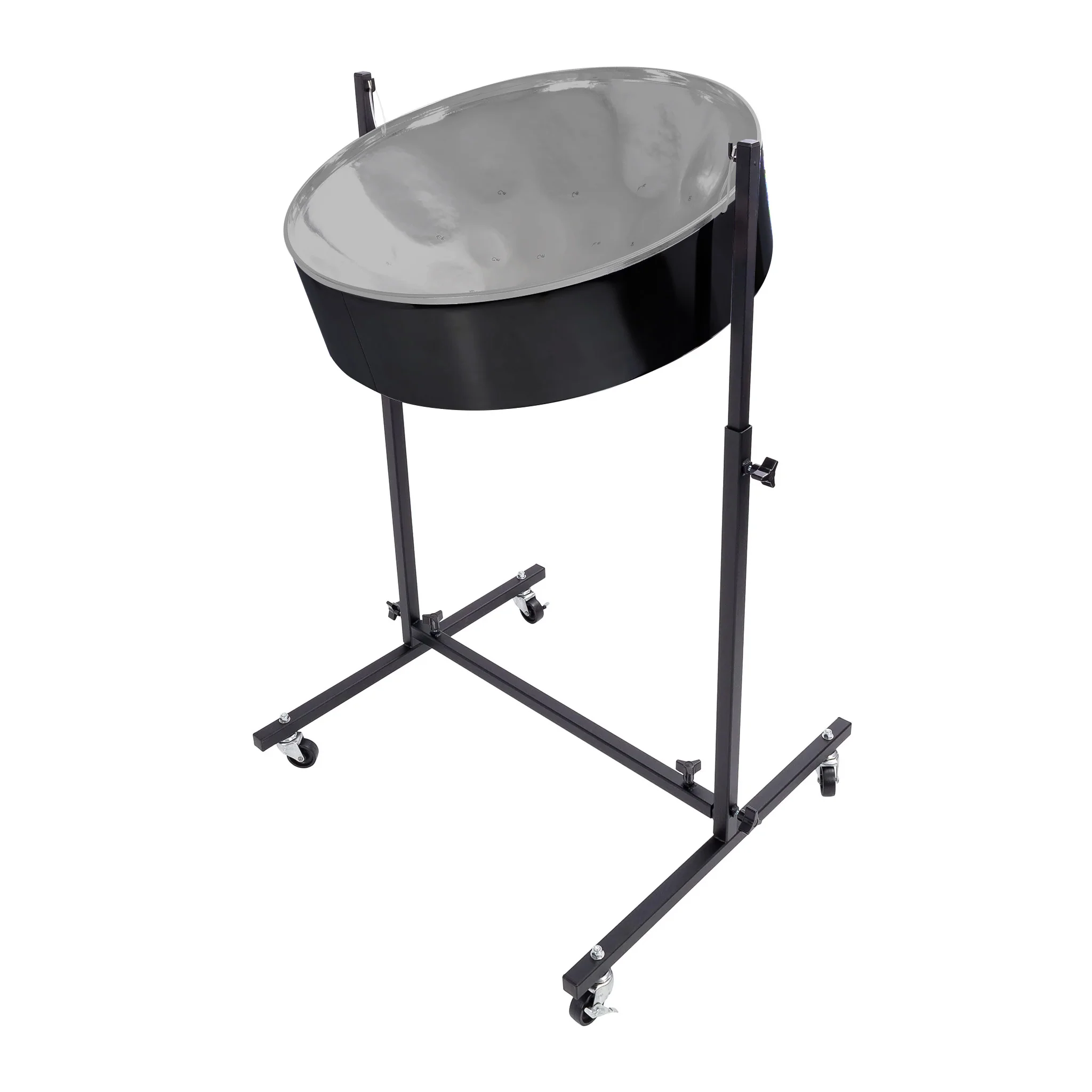Steel drum
Percussions
Africa
Between 1001 and 1900 AD
Video
The steel drum, also known as the steel pan, is a remarkable musical instrument that has captured the hearts of musicians and audiences alike. With its unique sound and vibrant cultural heritage, the steel drum has become a symbol of Caribbean music and identity.
Description and Features
The steel drum is classified as an idiophone, meaning it produces sound primarily through the vibration of the material itself. Traditionally made from 55-gallon oil drums, these instruments are carefully crafted to create a range of musical notes when struck. The surface of the drum is hammered into convex shapes to form specific pitches, allowing for a chromatic scale to be played. Steel drums typically come in various sizes and configurations, each designed to produce different ranges of sound. The most common types include bass pans, which produce deep tones; cello pans, which offer mid-range sounds; guitar pans for higher pitches; and ping pong pans which produce the highest notes. Each type serves a distinct purpose in ensemble playing. The construction of a steel drum involves meticulous tuning to ensure that each note resonates beautifully. This process includes hammering the surface of the drum to create “dimples” or “bosses” that define the pitch. The depth and curvature of these areas determine how each note will sound when struck. One of the most notable features of the steel drum is its ability to produce both melodic and rhythmic elements simultaneously. This versatility allows musicians to create intricate musical patterns that can be both soothing and energetic.
History and Origin
The history of the steel drum is deeply rooted in the cultural landscape of Trinidad and Tobago. Its origins can be traced back to the early 20th century when African slaves brought their musical traditions to the Caribbean. These traditions included various forms of drumming, which were integral to their cultural expression. In 1877, British colonial authorities banned traditional drumming to suppress African cultural practices during Carnival celebrations. This led to the emergence of alternative percussion instruments made from everyday items such as bamboo sticks and metal containers. The Tamboo Bamboo bands became popular during this period, utilizing bamboo tubes to create rhythmic sounds. As time progressed, musicians began experimenting with discarded oil drums left over from Trinidad’s burgeoning oil industry. In the 1930s, innovators started crafting these metal drums into musical instruments capable of producing melodic notes. Ellie Mannette is often credited as one of the pioneers in this transformation, developing techniques for tuning and crafting steel drums that would shape their modern form.
By the 1940s and 1950s, steel bands began to emerge as organized musical groups performing at local festivals and competitions. The popularity of steel drums grew rapidly, leading to their recognition as a legitimate musical instrument both locally and internationally.Today, the steel drum is celebrated not only as a national symbol of Trinidad and Tobago but also as an integral part of Caribbean music culture worldwide. Its rich history reflects resilience, creativity, and cultural pride.
Working Mechanism
The working mechanism of the steel drum relies on its unique construction and design. When struck with mallets—typically made from rubber or yarn—the surface of the drum vibrates at specific frequencies corresponding to its tuned notes. The vibrations travel through the metal material, producing sound waves that resonate through the air. Each note on a steel drum corresponds to a specific area on its surface. The size and shape of these areas are carefully calibrated during construction to ensure accurate pitch production. For example, smaller areas will produce higher pitches while larger areas yield lower tones. The resonant quality of a steel drum is enhanced by its concave shape and resonator tubes located beneath each note area. These tubes amplify the sound produced when a note is struck, allowing for greater volume and richness in tone. Additionally, players can utilize various techniques to manipulate sound production further. For instance, by varying their striking force or using different mallet types (soft or hard), musicians can achieve diverse tonal qualities ranging from mellow to bright sounds.
Types of Steel Drums
Steel drums come in several types based on their size, range, and intended use:
Bass Pan: This type produces deep tones and serves as the foundation for rhythm sections in steel bands.
Cello Pan: Offering mid-range sounds, cello pans are versatile instruments used for melodic lines within ensembles.
Guitar Pan: These pans play higher pitches and often carry melodies or harmonies in compositions.
Ping Pong Pan: Known for producing very high notes, ping pong pans add brightness to arrangements.
Tenor Pan: A popular choice among soloists due to its wide range; it can play both melody and harmony effectively.
Each type serves specific roles within musical contexts while contributing uniquely to overall ensemble sound.
Uses of Steel Drums
Steel drums have found applications across various musical genres:
- Calypso Music: Originating in Trinidadian culture, calypso music features lively rhythms accompanied by vibrant melodies played on steel drums.
- Soca Music: A fusion genre that combines calypso with other Caribbean styles; steel drums play a central role in creating infectious dance rhythms.
- Jazz: Many jazz musicians incorporate steel drums into their performances for added texture and melodic possibilities.
- Classical Music: Composers have begun integrating steel drums into orchestral works due to their unique tonal qualities.
- Popular Music: Artists from diverse genres utilize steel drums for their distinctive sound; they often appear in pop songs or world music collaborations.
Significance of Steel Drums
The significance of steel drums extends beyond mere entertainment; they represent cultural heritage and community identity within Trinidadian society. As an instrument born out of adversity—stemming from colonial restrictions on traditional drumming—the steel drum embodies resilience through creativity. In educational settings, learning how to play the steel drum fosters appreciation for Caribbean culture while enhancing students’ musical skills such as rhythm recognition and coordination between hands. Moreover, as global interest grows in world music traditions—steel drums serve as powerful tools for bridging cultural gaps through shared experiences among diverse audiences. In conclusion, whether resonating through vibrant carnival celebrations or soothing listeners during intimate performances—the steel drum remains an enduring symbol not only within Trinidadian culture but also across global musical landscapes.
FAQ
What are the characteristics of a steel drum musical instrument?
The steel drum, or steelpan, is a percussion instrument crafted from a 55-gallon oil drum. Its surface is hammered and tuned to create distinct pitches, producing a rich, melodic sound. Steel drums are played with rubber-tipped mallets and are known for their bright, resonant tone. They are versatile, used in genres such as calypso, reggae, and classical music.
What is the origin of the steel drum?
The steel drum originated in Trinidad and Tobago during the early 20th century. It evolved from African drumming traditions and the use of metal objects like biscuit tins and oil drums for rhythm. By the 1940s, it became a refined musical instrument and an essential part of the region's cultural identity and carnival celebrations.
What are the types of steel drum available?
Steel drums come in various types based on their range and function. Common types include the tenor pan (highest range, for melodies), double second pan (mid-range, for harmonies), and bass pan (lowest range, for rhythm). Each type contributes to the unique sound of a steelband ensemble, offering a wide range of musical possibilities.
 Links
Links
References
Other Instrument
Categories



















